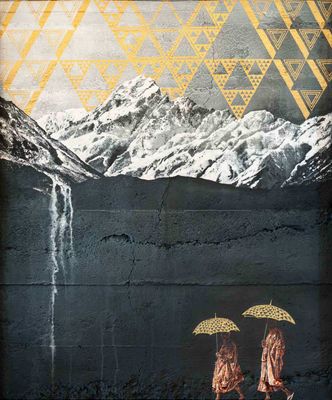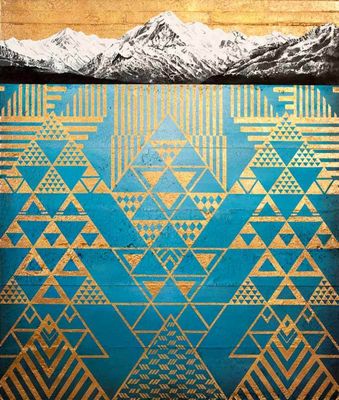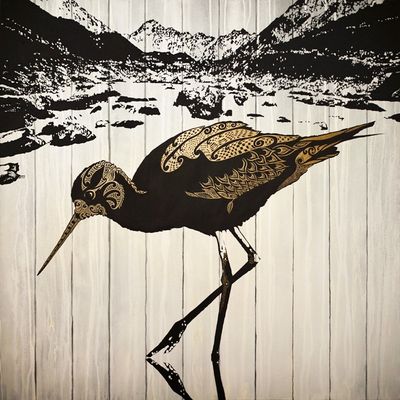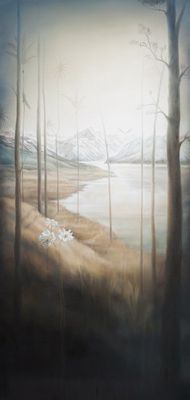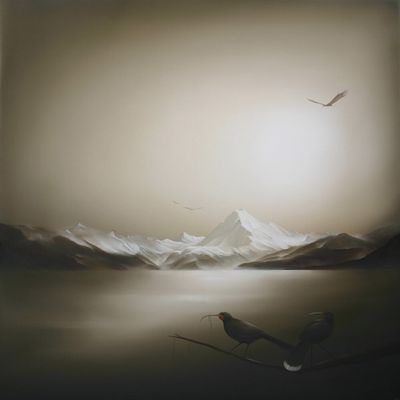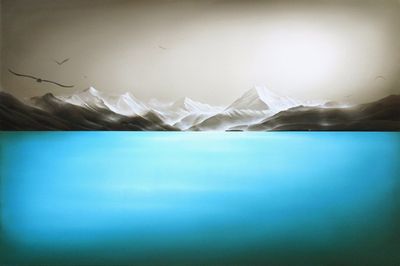

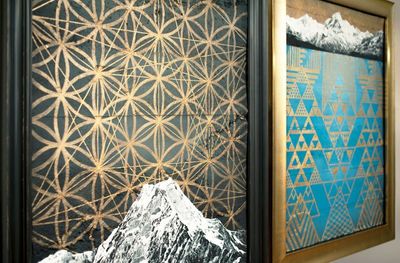
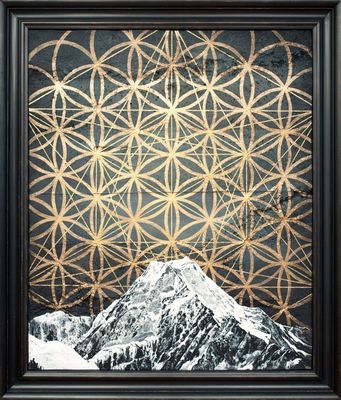
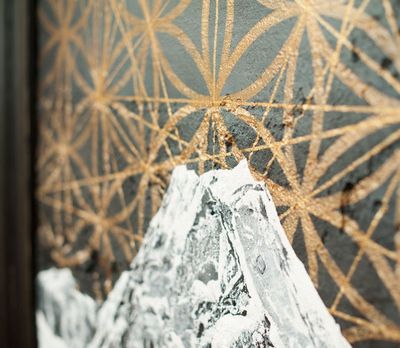
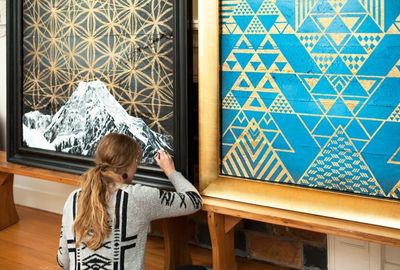

Aoraki Raama
$2,000.00
or 6 weekly payments from $333.33 learn more
Explore the story of the artwork >>
Print sizes and editions
- Regular museum archival paper print - 583 x 700mm
(limited to 95) - Large museum archival paper print - 827 x 992mm
(limited to 95) - Extra Large museum canvas print - 950 x 1138mm
(limited to 95)
Your unique limited edition fine art print
- Sofia Minson creates your exclusive signed print
- We ship for $25 in NZ and from $50 internationally
- Your artwork arrives rolled, ready to be framed - do you need help? Request framing guidance
Original painting SOLD, flashe on moulded fibreglass board, 1320 x 1540mm (including antique wooden frame), 2017
The story of Aoraki Raama
Here stands our tallest peak in New Zealand, Aoraki Mt Cook. Ngāi Tahu's sacred mountain is crowned with gold geometric patterns. The Hindu god Raama illuminates the expansive night sky.
The substrate I was working on lent character and direction to "Aoraki Raama." It is fibreglass board, moulded with the deep cracks like gnarled concrete. I had three such boards to work on and all three drew out rugged, rocky, snow covered Aoraki from my imagination.
The legend of Aoraki, Cloud in the Sky
There was once no Aotearoa, the waters of kiwa covered the land. Rakinui, Sky Father, wedded Papatūānuku, Earth Mother. Raki's four sons including Aoraki, came down to greet their father's new wife. They travelled in a canoe called Te Waka o Aoraki and met Papatūānuku. She lay as one body in a huge continent known as Hawaiiki.
Keen to explore, the voyagers set out to sea, but no matter how far they paddled, they could not find land. They decided to return to their celestial home but the karakia (incantation) which should have lifted the waka back to the heavens, failed. The canoe fell back into the sea, turning over onto its side and becoming stone and earth in the process.
The formation of the Southern Alps
The waka formed the South Island of New Zealand, known today as Te Waka o Aoraki. Aoraki and his brothers clambered on to the high side of the waka and were also turned to stone. Aoraki remains as the highest peak of the Southern Alps. His brothers are neighbouring mountains.
As a great Ngāi Tahu ancestor embodied in the mountain, Aoraki provides an important link between the supernatural and natural worlds. The highest places on earth are often tapu (sacred). They are powerful conduits between earth and dimensions beyond.
The people of Ngāi Tahu trace their lineage back to Tahupōtiki, the younger brother of Porourangi who was one of the great ancestors of Ngāti Porou - Sofia's own iwi.
The Flower of Life Pattern
In this work, the pattern of the Flower of Life hovers above Aoraki in the night sky. It is a mathematical geometry outside of culture and religion. It originates from nature. It is one of the oldest sacred symbols known to man and is found in ancient civilisations all over the world. Incredibly every one of those civilizations gave it the same name, the Flower of Life.
I imagine the first circle as primal consciousness emerging from a single point in Te Pō - the long night in Māori creationary myth. Awareness then moves to the edge or circumference of its own limits and radiates outwards in a second circle, intersecting with the first. Awareness is perfect and can therefore do this same thing from many different points on the original boundary simultaneously, creating the seed of life. Consciousness then unfolds outwards as an infinite, connected pattern of awareness.
Connecting the centres
The Flower of Life is made up of overlapping circles of the same size with six fold symmetry. When you connect the centres of 13 significant circles with straight lines as I have done here, you get metatron's cube. Within metatron's cube you can create an illusion of all five platonic solids.
Leonardo da Vinci was interested in how the Flower of Life revealed principles of mathematics such as Phi and the Fibonacci Spiral, which govern physical reality.
The legend of Raama
When painting this piece, I imagined the geometric pattern speaking the name Raama. In Hinduism, the two most important incarnations of Vishnu, the preserving force in the universe, are Raama and Krishna. They are different names for the same essence.
I associate Raama with the night sky in this work because in Sanskrit, Raama means dark, black and night. The patterns in gold reflect other Vedic texts, in which Raama means pleasing, delightful, beautiful and lovely.
Living a righteous path
Raama is the central figure of the ancient epic Ramayana. He is all-compassionate and cares for all living beings. The entire life story of Raama and his companions illustrates how to live a righteous path. In some texts Raama is the non-dualistic Supreme Being, the eternal, blissful, spiritual self or the atman.
We can sense this atman or awareness in ourselves when we're totally present. We can experiment getting in touch with the atman by becoming "the watcher." We don't have to identify ourselves with every random thought and emotion. We can try observing the thoughts and feelings in the body as weather or clouds passing by, treating them with compassion, as we would a child who we love.
Maha mantra
From the 15th century onwards, this maha mantra (great utterance) rose to importance:
"Hare krishna hare krishna, krishna krishna hare hare, hare raama hare raama, raama raama hare hare."
Hare is the female goddess or energetic aspect of Vishnu, and also means "to take away" one's suffering and sins. Saying the 16 words many times with sincere feeling is a powerful devotional practice. Gratitude and love start to flow through the body.
Raama is milder and more reserved than the prank-playing extrovert personality of Krishna. The views of Rama combine reason with emotions to create a "thinking hearts" approach. The life story of Raama is a masterpiece like other major epics and religious stories from around the world. It offers a framework to conceptualise the nature of life and how we should act in the world.
What is Aoraki Raama?
The name "Aoraki Raama" brings two gods and two mythological traditions together - Maori and Hindu. This binding of the two gods in the title was instinctual. As I worked on the piece I was able to understand the connections more fully.
Aoraki is acting as a conduit between the heavens and the earth. This channel allows Raama to come through in the form of the geometric Flower of Life. A pattern, which is the building block of life itself.
A pure state of awareness
To speak the name Raama is to vocalise the eternal, blissful self, whose quality is loving compassion. This pure state of awareness is also the building block of life.
The message I'm getting from the painting is that it is up to us to experience our own Raama essence within the centre of our own being. We need to rely less on the dualism of our left and right brain hemispheres. We can actually reorientate ourselves in our bodies and live more in our heart, where oneness resides.
Sofia Minson Paintings | New Zealand Artwork
